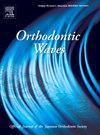戒烟可以挽救由烟草烟雾成分引起的牙齿运动延迟
IF 0.5
Q4 DENTISTRY, ORAL SURGERY & MEDICINE
引用次数: 1
摘要
摘要目的:接受正畸治疗的吸烟者偶尔需要更长的治疗时间。然而,目前尚不清楚是否可以通过鼓励戒烟来恢复延迟的牙齿运动。这项研究旨在检验用烟草烟雾成分综合混合物(TSCs)治疗的大鼠是否可以通过一段时间的戒烟来恢复牙齿运动率。材料和方法:9周龄Wistar雄性大鼠分为不治疗组、假手术组、TSS组和停止TSS组。未治疗组和假手术组的大鼠饮用蒸馏水,而TSS组和停止TSS组的大白鼠在饮用水中饮用TSS。在三组大鼠进行牙齿移动之前,TSCs停止组大鼠的戒烟期为10天。使用微型计算机断层扫描测量牙齿移动距离,并从组织学角度评估破骨细胞分化。结果:假手术组和TSCs停止组的牙齿运动明显大于TSCs组。然而,与假手术组相比,停止TSCs组显示出较少的破骨细胞分化。结论:我们的研究结果表明,吸烟引起的延迟性牙齿移动通过戒烟治疗得以恢复;这种恢复似乎部分是由于破骨细胞的增加,尽管破骨细胞数量仍低于假手术组。本文章由计算机程序翻译,如有差异,请以英文原文为准。
Smoking cessation rescues tooth movement delays caused by tobacco smoke components
ABSTRACT Purpose: Smokers who receive orthodontic treatment occasionally require longer treatment periods. Nevertheless, it is unclear whether delayed tooth movement can be recovered by encouraging smoking cessation. The study was designed to examine whether tooth movement rates can be recovered by a period of smoking cessation in rats treated with a comprehensive mixture of tobacco smoke components (TSCs). Materials and methods: Nine-week-old Wistar male rats were divided into no treatment, sham, TSCs, and TSCs cessation groups. The rats in the no treatment and sham groups drank distilled water, whereas those in the TSCs group and the TSCs cessation groups received TSCs in their drinking water. A smoking cessation period of 10 days was set for rats in the TSCs cessation group before the three groups underwent tooth movement. Tooth movement distance was measured using micro-computed tomography, and osteoclast differentiation was evaluated histologically. Results: There was significantly greater tooth movement in the sham and TSCs cessation groups than in the TSCs group. However, the TSCs cessation group showed lesser osteoclast differentiation than the sham group. Conclusion: Our results indicate that delayed tooth movement caused by smoking was recovered by smoking cessation treatment; this recovery seems to be partially due to the increase in osteoclasts, although the number of osteoclasts was still less than that in the sham group.
求助全文
通过发布文献求助,成功后即可免费获取论文全文。
去求助
来源期刊

Orthodontic Waves
DENTISTRY, ORAL SURGERY & MEDICINE-
CiteScore
0.40
自引率
0.00%
发文量
0
期刊介绍:
Orthodontic Waves is the official publication of the Japanese Orthodontic Society. The aim of this journal is to foster the advancement of orthodontic research and practice. The journal seeks to publish original articles (i) definitive reports of wide interest to the orthodontic community, (ii) Case Reports and (iii) Short Communications. Research papers stand on the scientific basis of orthodontics. Clinical topics covered include all techniques and approaches to treatment planning. All submissions are subject to peer review.
 求助内容:
求助内容: 应助结果提醒方式:
应助结果提醒方式:


